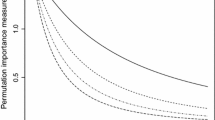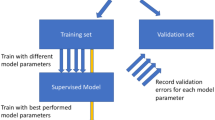Abstract
This paper extends the concept of dispersion variance to the multivariate case where the change of support affects dispersion covariances and the matrix of correlation between attributes. This leads to a concept of correlation between attributes as a function of sample supports and size of the physical domain. Decomposition of dispersion covariances into the spatial scales of variability provides a tool for computing the contribution to variability from different spatial components. Coregionalized dispersion covariances and elementary dispersion variances are defined for each multivariate spatial scale of variability. This allows the computation of dispersion covariances and correlation between attributes without integrating the cross-variograms. A correlation matrix, for a second-order stationary field with point support and infinite domain, converges toward constant correlation coefficients. The regionalized correlation coefficients for each spatial scale of variability, and the cases where the intrinsic correlation hypothesis holds are found independent of support and size of domain. This approach opens possibilities for multivariate geostatistics with data taken at different support. Two numerical examples from soil textural data demonstrate the change of correlation matrix with the size of the domain. In general, correlation between attributes is extended from the classic Pearson correlation coefficient based on independent samples to a most general approach for dependent samples taken with different support in a limited domain.
Similar content being viewed by others
REFERENCES
Goulard, M., and Voltz, M., 1992, Linear coregionalization: Tools for estimation and choice of crossvariogram matrix: Math. Geology, v. 24, no. 3, p. 269–286.
Journel, A. G., and Huijbregts, Ch. J., 1978, Mining geostatistics: Academic Press, New York, 600 p.
Miesch, A. T., 1975, Variograms and variance components in geochemistry and ore evaluation: Geol. Soc. America, Mem. 142, p. 333–340.
Myers, D. E., 1993, Change of support and transformations, in Dimitrakopoulos, R., ed., Geostatistics for the next century: Kluwer Academic Publ., Dordrecht, pp. 253–258.
Myers, D. E., 1994, The linear model and simultaneous diagonalization of the variogram matrix function, in Fabbri, A. G., and Royer, J. J., eds., 3rd CODATA Conference on Geomathematics and Geostatistics: Sci. de la terre, Sér, Inf., Nancy, v. 32, p. 125–139.
Myers, D. E., 1997, Statistical models for multiple scaled analysis, in Quattrochi, D. A., and Goodchild, M., eds., Scale in remote sensing and GIS: Lewis Publishers, p. 273–294.
Rendu, J. M., 1978, An introduction to geostatistical methods of mineral evaluation: South African Institute of Mining and Metallurgy, Johannesburg, 84 p.
Russo, D., and Jury, W., 1987, A theoretical study of the estimation of the correlation scale in spatially variable fields: Water Resources Res., v. 23, no. 7, p. 1257–1268.
Sandjivy, L., 1984, The factorial kriging analysis of regionalized data. Its application to geochemical prospecting, in Verly, G., and others, eds., Geostatistics for natural resources characterization, NATO-ASI Series C: v. 122, Reidel Publ. Co., Dordrecht, p. 559–572.
Smith, H. F., 1938, An empirical law describing heterogeneity in the yields of agricultural crops: Jour. Agr. Science, v. 28, p. 1–23.
Wackernagel, H., 1985, The inference of the linear model of coregionalization in the case of a geochemical data set: Ecole des Mines de Paris, Centre de Geostatistique et de Morphologie Mathematique, Fontainebleau, p. 14.
Wackernagel, H., 1988, Geostatistical techniques for interpreting multivariate spatial information, in Chung, C. F., and others, eds., Quantitative analysis of mineral and energy resources, NATO ASI series C 223: Reidel Publ. Co., Dordrecht, p. 393–409.
Warrick, A. W., and Myers, D. E., 1987, Optimization of sampling locations for variogram calculations: Water Resources Res., v. 23, no. 3, p. 496–500.
Warrick, A. W., Musil, S. A., Artiola, J. F., Hendricks, D. E., and Myers, D. E., 1990, Sampling strategies for hydrological properties and chemical constituents in the upper vadose zone, final technical report: University of Arizona, Tucson, Arizona, 117 p.
Xie, T., and Myers, D. E., 1995, Fitting matrix valued variogram models by simultaneous diagonalization: I Theory: Math. Geology, v. 27, no. 7, p. 867–876.
Zhang, R., Warrick, A. W., and Myers, D. E., 1987, Variance as a function of sample support size: Math. Geology, v. 22, no. 1, p. 107–121.
Author information
Authors and Affiliations
Rights and permissions
About this article
Cite this article
Vargas-Guzmáan, J.A., Warrick, A.W. & Myers, D.E. Multivariate Correlation in the Framework of Support and Spatial Scales of Variability. Mathematical Geology 31, 85–103 (1999). https://doi.org/10.1023/A:1007545431115
Issue Date:
DOI: https://doi.org/10.1023/A:1007545431115




